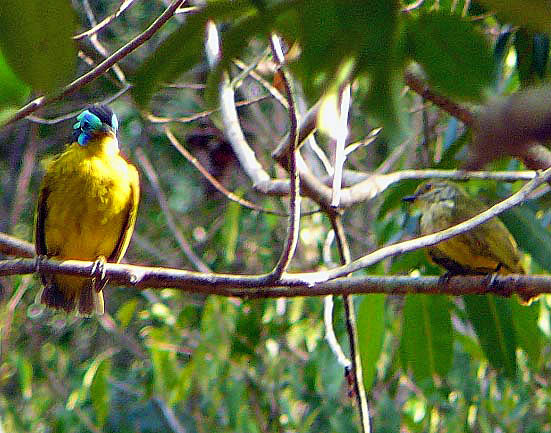
a web page by Don Roberson |
ASITIES Philepittidae |
|
They have traditionally been considered one of the five families of birds found only in Madagascar, along with mesites, ground-rollers, cuckoo-roller, and vangas [the Vangidae, however, has recently been enlarged to include birds, like helmetshrikes, that are on mainland Africa, and is no longer an endemic Madagascar family]. There are four species of asity, and each quite unique. A prized and local species is Schlegel's Asity (left; photo of a pair by Lois Goldfrank). As can be seen in the photo, the male has a colorful blue wattle around the eye. In fact, the males of all four asities are iridescent blue or green facial wattles. There are two genera in the family but 3 of the 4 males are yellow below; only Velvet Asity Philepitta castanea has a velvety black plumage |
| All asities are difficult birds to observe and photograph in their rainforest habitat. Both sunbird-asities in genus Neodrepanis have decurved bills, recalling some sunbirds. I have seen a nesting pair of Common Sunbird-Asity in the subcanopy, and have only a terrible pre-digital slide. |
Asities build ragged globular nests which are hung from the tips of branches. Nest construction is apparently only by females who first build a hollow sphere and then poke a hole in the side for an entrance. The male photographed in Ranamanfana Reserve was hanging around such a nest in a social group that included another male, a female, and an immature male. Later, in Perinet Reserve, a local guide took us to an old asity nest that was then being used as day-time sleeping quarters for an Eastern Mouse-Lemur Microcebus murinus smithii, which sleepily poked out its head at our approach, gave us a quick look, and retreated back inside. Male Velvet Philepitta castanea and both sunbird-asities engage in wing-fluttering and gape-opening displays, but I have not witnessed those. The two species which I did not see [Schlegel's Asity Philepitta schlegeli and Yellow-bellied Sunbird-Asity Neodrepanis hypoxantha] are scarce and local. A fine article on the identification and status of the two species in the genus Neodrepanis is Hawkins et al. (1997). The two Neodrepanis asities are nectarivorous. Schlegel's Asity is more of a frugivore but it, like Neodrepanis, has a brush-tipped tongue. Prum (1993) studied the phylogeny and biogeography of the asities and broadbills and presented evidence that the asities were just a subfamily of broadbills. Moyle et al. (2006) used additional genetic and other evidence that helped to sort out their true relationships. As it turns out, the broadbill stock arose perhaps 70 million years ago and for some time (perhaps 10 million years) evolved on India when it was still a huge isolated landmass in the Indian Ocean. When India first crashed into the Eurasian continent in the Paleocene, broadbills spread east (to southeast Asia) and west (to Africa) and in that very warm period, likely north as well. As climate cooled, presumably many species became extinct. Broadbills split into two main branches about 55 million years ago. One of those branches included the Eurylaimid Broadbills, the Sapayoa in the New World, and Asities. Sapayoa became isolated at least 52 million years ago. At some point about 35-45 million years ago, the ancestral asity became isolated in Madagascar, where the lineage has evolved ever since. Thus all broadbills, asities, and the Sapayoa, have a common ancestor. One way to look at the evidence is to lump all of them in one huge broadbill assemblage. Another way of handling the exact same evidence is to create four families: the Calyptomenid Broadbills, the Eurylaimid Broadbills, the Asities, and the Sapayoa. To retain Asities as a family, one must make all those splits. Asities have traditionally been considered a family, and the Handbook of the Birds of the World series retained them as a separate family. Making the four-way split, and retaining Asities as a family, is consistent with the way the South American Checklist Committee (and this web site) handled a similar problem with the barbet/toucan assemblage. They either had to be one huge family (including toucans), or five separate families. SACC made the latter choice, and I very much approve. I now handle the broadbill/asity problem in the same way. [Note: while the page layout was reformatted in 2021, I've generally retained the original 1999 text, written at a time when the phylogeny of these groups was in flux. Today, of course, most of the above is established conventional wisdom.] |
Photos: The pair of Schlegel's Asity Philepitta schlegeli was photographed by Lois Goldfrank at Ampijoroa, Madagascar, on 9 Nov 2006. All photos © Don Roberson, except for that credited © Lois Goldfrank, and used with permission; all rights reserved. Family book:
The Handbook of the World volume covering this family (Hawkins 2003) was, as expected, spectacular. But they did not anticipate the findings about the true relationships in the broader broadbill group. Literature cited:
|
 The Asities are a small group of tiny specialized arboreal passerines found only in Madagascar. Recent molecular evidence (Prum 1993, Moyle et al. 2006) showed that asities arose from the same lineage as today's broadbills in Asia and Africa (see below).
The Asities are a small group of tiny specialized arboreal passerines found only in Madagascar. Recent molecular evidence (Prum 1993, Moyle et al. 2006) showed that asities arose from the same lineage as today's broadbills in Asia and Africa (see below). 